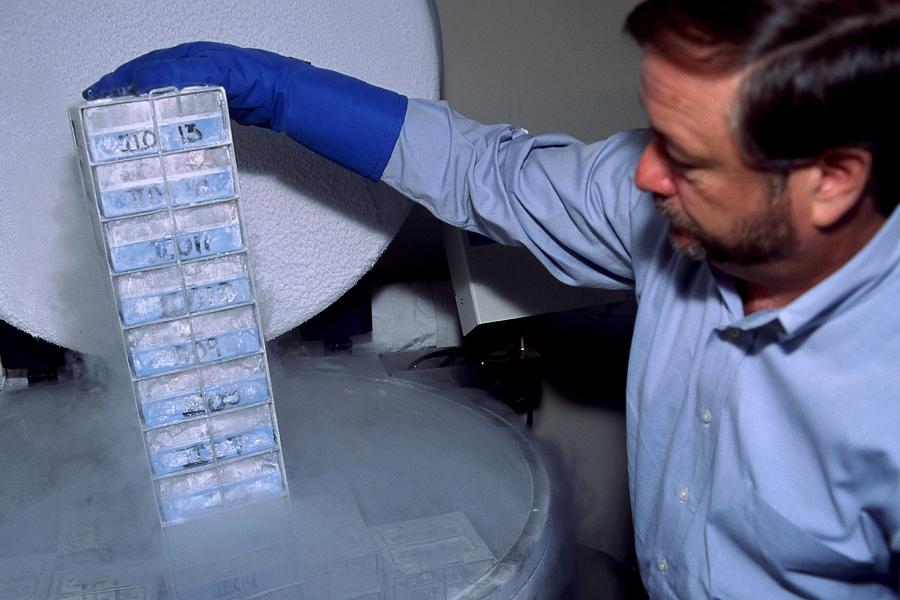Frozen Zoos
Wildlife Conservation has come a long way in the past 50 years. In 1972, a cryopreservation bank was established at the San Diego Zoo in California that contained DNA samples from endangered animals. The "Frozen Zoo" stores living samples of skin tissue, embryos, sperm, and eggs from 800 species of animals that are not far from extinction, using a technique called cryopreservation. (36) Oliver Rider, a professor of biology at the San Diego Zoo shows a collection of animal tissue samples at the "Frozen Zoo." (right) |  |
Cryopreservation
Cryopreservation is the process of freezing cell or tissue samples from living organisms in liquid nitrogen at about -196 degrees Celsius. The freezing stops cell activity and preserves the sample for many years. It's very difficult to freeze cells because cryoinjuries can occur if the cell absorbs any chemicals through its permeable membrane. Cryoprotectants are chemicals like Dimethylsulfoxide, ethylene glycol, and glycerol, which aid in preventing cryoinjuries. Vitrification has proven to be one of the best forms of cryopreservation, for it combines ultra-rapid freezing methods with large concentrations of cryoprotectants. (37)
Cloning Endangered Species Already the Frozen zoo has proven to be able to "bring back species from the dead." Recently, the Scripps Research Institute succeeded in turning skin samples from San Diego's frozen zoo into induced pluripotent stem (IPS) cells. These stem cells could then technically be coaxed into becoming sperm or egg cells, which could be used in IVF procedures. Eager to see if the IPS cells would work from a long dead animal, scientists took frozen skin samples from a Drill Monkey, an endangered species from Africa, and on June 1, 2010, the stem cells morphed into brain cells. This technology proves to be a great possibility for adding new gametes to the gene pool of endangered species. (36)
|  |
Cloning Extinct Species The next step to cloning deceased animals is cloning long-extinct species. Scientists in Japan have recently begun the process of cloning a long-dead wooly mammoth. By using tissue from a dead specimen in Russia, Akira Iritani and his team from Kyoto University hope to take the nucleus from the mammoth cell and inject it into the egg cell of an African Elephant, the mammoth's closest living relative. This egg cell with the mammoth nucleus will be implanted into the uterus of a female African Elephant, which will grow into the embryo of a mammoth and be born naturally as if it were a regular elephant. (38) |  |
Ethics
Unfortunately, humans have caused so much stress on biodiversity and natural ecosystems that it is imperative that we take immediate action to conserve as many species as possible. However, the question of how far we go with this action often arises. It is true that the best way of conserving species is to simply reduce our encroachment on wild habitat and to regulate hunting and fishing, but for many ecosystems, the damage has already be done.
For species directly on the brink of extinction, frozen zoos may be the last hope. For example, the Northern white rhino is a critically endangered subspecies of the white rhino, with only 8 individuals left on the planet.
San Diego's frozen zoo contains genetic samples of this subspecies. (36) However, with the technology to bring back extinct species, is it ethical to clone a mammoth that naturally went extinct thousands of years ago, or even a species, like the Hawaiian Po'ouli bird, which went extinct just a couple years ago due to habitat loss brought on by humans? According to Oliver Ryder, a biologist at the San Diego Zoo, the frozen zoo was created to keep a kind of "ark" on endangered species who might suffer drastic decline in the future, and also to serve as a bank of gametes to increase an endangered species' genetic purity.
Ryder believes that the cloning of extinct species takes away from these objectives; the frozen zoo must focus on preventing further losses of species, and not the regeneration of extinct species. (36)
Back to Ex-Situ Conservation | What are Seed Banks? |